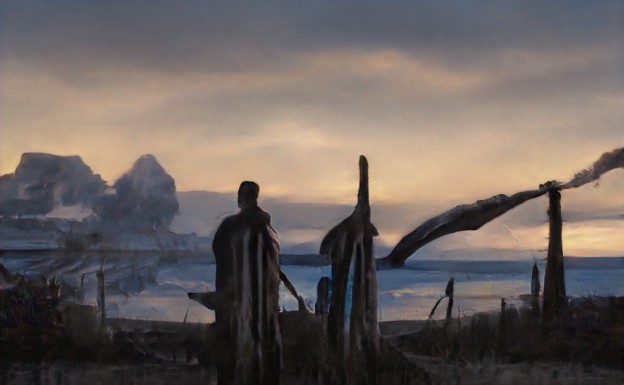Internet Harvest is a selection of the most succulent links on the internet that I’ve recently plucked from its fruitful boughs. Feel free to discuss the links in the comments.
Also, semi-intentionally, none of the links in this harvest are COVID-19-related. If you want some interesting distractions, you might like this post.
First, an eternal recommendation for the SCP Foundation’s Antimemetics Division series. (“Antimemes” are information that resists sharing.) It’s smart, creepy, mind-bending fiction in which a variety of clever protagonists try to save the world from an enemy who they can’t remember exists. The final story in the series is being posted very soon, and you’ll have a lot to work through before then.
“Negative ion” products on Amazon: not only do they not work, many of them are literally impregnated with thorium powder. AAAAAAAAAAAAAAAAAAAA. h/t Lorelei.
“Dreamy labyrinthine architecture that is somehow both crushingly oppressive and unimaginably vast” alert: These man-made caverns in New York State.
Relatedly, you should be following BLDGBLOG, a blog about buildings and so much more.
If you can’t find dreamy labyrinthine architecture in real life, you can make your own. Artbreeder.com is a wonder and free to use. If you’ve tried it before, check again, because in addition to the table-deer-mop hybrids of your dreams, it now allows you to make landscapes and disturbingly realistic human portraits to your desired specifications. Wondering where I got the cover image for this post? I’ve picked up oil painting during self-isolation, I call this one “Lost Carcosa” – just kidding, an AI and I made it in five minutes.
John J Audubon recorded a species of giant eagle he’d occasionally seen in the American midwest. To date, nobody else has found that bird.
Here’s a species of fungus that is found in a little region in Japan, a little region in Texas, and literally nowhere else on earth.
First major use of deepfakes in an election was surprisingly not terrible (“translating” a video of an Indian politician into another language, as though the politician were speaking it himself.)
I’ve harbored a longtime fascination with domestic life, housekeeping, cooking, etcetera – both modern and past. This surprises a lot of people. It was actually a large part of my interest in working on The Funnel of Human Experience – so much of human history was spent by people, mostly women, keeping the home running and the fires hot and the children clothed. In the late 1800s, Ellen Swallow Richards turned the art of home economics into a science – people studying the most time-effective way to make a bed, the best nutrition for a family, sanitation and food safety at home and standardization. There was the 1870’s MIT Women’s Laboratory, and later there were universities with actual living orphan “practice” babies, who the students practiced caretaking on. There are whole books’ worth of history here. (And if you know any good ones about anything on this topic, please let me know.) Anyway, Efficiency is Everything – Industrial engineering applied to life is a re-discovery of the topic for the modern age.
Explorable.es: Some delightful interactive scientific/technical concept-explainers.
We’ve had sci-fi. There’s worldbuilding fiction, of whole planets and cultures and sentient species. Some of my friends are interested in “soc-fi”, fictional plausible societies. There are con-langs and alternate histories and speculative biology. There’s even time-fi. And now, finally, we have food fiction – fun recipes with beautiful results that don’t work! Unfortunately, it’s masquerading as those short viral videos from Blossom, Five Minute Crafts, So Yummy, etc, that you see all over facebook and youtube, and it’s also known as “lying for profit.”
Trees that harvest high amounts of metals from the soil, so much that e.g. nickel trees exude green sap. BLDGBLOG calls this “metallurgical druidry.”
Sandy Island, New Caledonia: an island near Australia that was discovered not to exist in 2012. This is part of a phenomenon known as “phantom islands.”
A wholesome online retail store that sells zoo animal toys.
Why does a tiny spot in rural Maine produce as much light at night as some cities? Identification of unexpected light sources from a global map of light pollution. (Fun game: try to guess each source before you learn what the answer is.)
A very intense online “game”: Look at videos of lifeguard rescues in swimming pools. See if you can find and click on the drowning kid before the lifeguard rescues them. May be good if you spend a lot of time around kids (or adults?) in water.
Do you know about David Goodsell’s biology art? He makes gorgeous drawings of cells, molecular mechanisms, etcetera, that are also considered good representations of how much stuff there actually is in a cell. A lot more than the sort of sterile, structured drawings you saw in intro biology textbooks.
This Dutch company trains eagles to take down drones. A news article notes:
“What I find fascinating is that birds can hit the drone in such a way that they don’t get injured by the rotors,” said LeBaron [of the Audubon society]. “They seem to be whacking the drone right in the centre so they don’t get hit; they have incredible visual acuity and they can probably actually see the rotors.”
Humans, of course, only see rotors as a blur – LeBaron suspects that the eagles can make out the complete movement and thus have no trouble avoiding injury. It doesn’t hurt, either, that attacking a drone the way a bird might attack another bird is usually effective. “Their method of attack is always going to be to hit it in the middle of the back; with the drones they perceive the rotors on the side and so they just go for the rear.”
This is fascinating and also checks out with the observation that smaller animals, notably birds, seem to have a much faster perception than humans.
It seems like smart speakers, bluetooth headsets, and the like can be hacked to produce harmful levels of sound. Great! That’s another entry for the bestiary.


